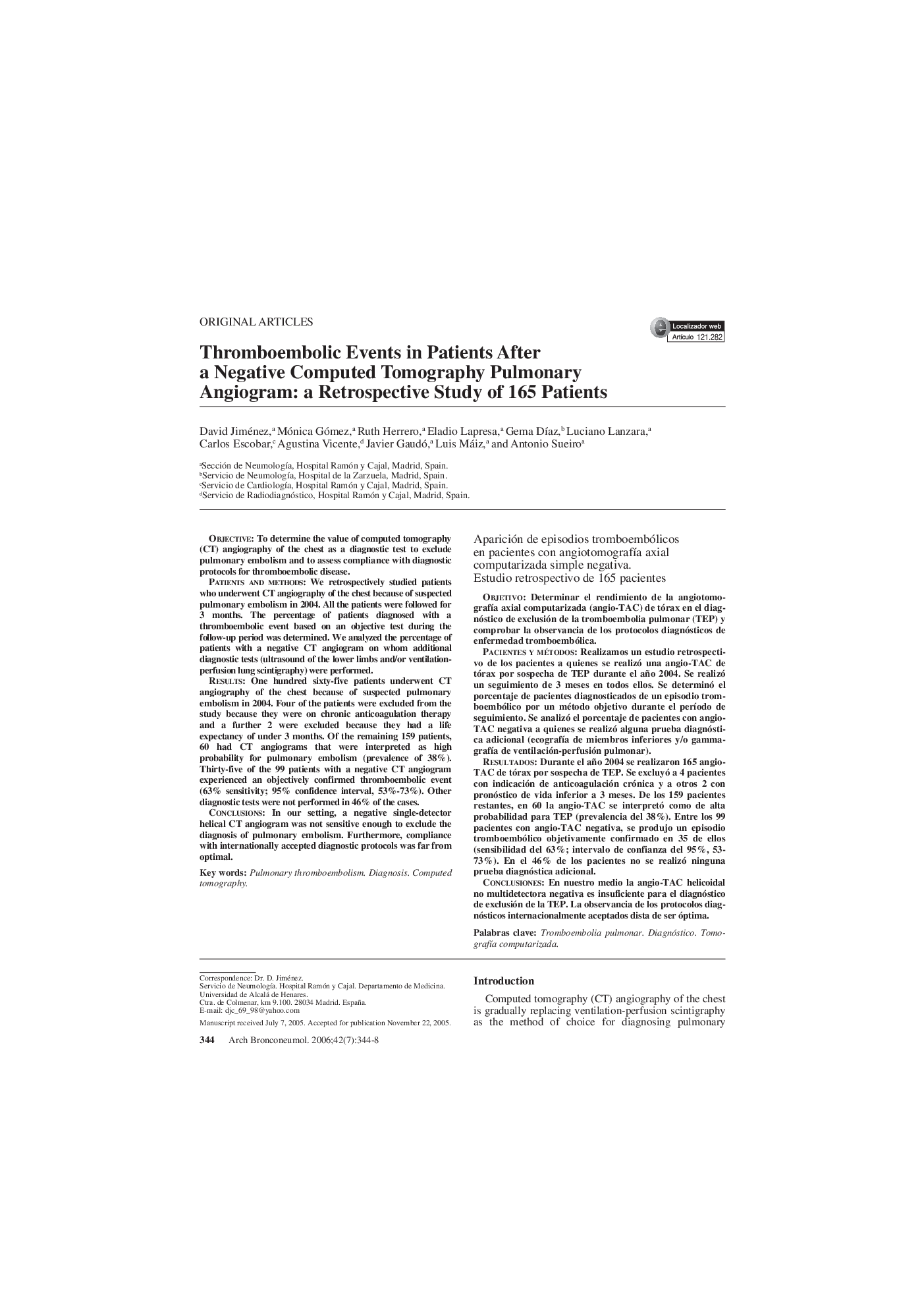| کد مقاله | کد نشریه | سال انتشار | مقاله انگلیسی | نسخه تمام متن |
|---|---|---|---|---|
| 4206951 | 1280035 | 2006 | 5 صفحه PDF | دانلود رایگان |

ObjectiveTo determine the value of computed tomography (CT) angiography of the chest as a diagnostic test to exclude pulmonary embolism and to assess compliance with diagnostic protocols for thromboembolic disease.Patients and methodsWe retrospectively studied patients who underwent CT angiography of the chest because of suspected pulmonary embolism in 2004. All the patients were followed for 3 months. The percentage of patients diagnosed with a thromboembolic event based on an objective test during the follow-up period was determined. We analyzed the percentage of patients with a negative CT angiogram on whom additional diagnostic tests (ultrasound of the lower limbs and/or ventilation-perfusion lung scintigraphy) were performed.ResultsOne hundred sixty-five patients underwent CT angiography of the chest because of suspected pulmonary embolism in 2004. Four of the patients were excluded from the study because they were on chronic anticoagulation therapy and a further 2 were excluded because they had a life expectancy of under 3 months. Of the remaining 159 patients, 60 had CT angiograms that were interpreted as high probability for pulmonary embolism (prevalence of 38%). Thirty-five of the 99 patients with a negative CT angiogram experienced an objectively confirmed thromboembolic event (63% sensitivity; 95% confidence interval, 53%–73%). Other diagnostic tests were not performed in 46% of the cases.ConclusionsIn our setting, a negative single-detector helical CT angiogram was not sensitive enough to exclude the diagnosis of pulmonary embolism. Furthermore, compliance with internationally accepted diagnostic protocols was far from optimal.
ObjetivoDeterminar el rendimiento de la angiotomografía axial computarizada (angio-TAC) de tórax en el diagnóstico de exclusión de la tromboembolia pulmonar (TEP) y comprobar la observancia de los protocolos diagnósticos de enfermedad tromboembólica.Pacientes y métodosRealizamos un estudio retrospectivo de los pacientes a quienes se realizó una angio-TAC de tórax por sospecha de TEP durante el año 2004. Se realizó un seguimiento de 3 meses en todos ellos. Se determinó el porcentaje de pacientes diagnosticados de un episodio tromboembólico por un método objetivo durante el período de seguimiento. Se analizó el porcentaje de pacientes con angio-TAC negativa a quienes se realizó alguna prueba diagnóstica adicional (ecografía de miembros inferiores y/o gammagrafía de ventilación-perfusión pulmonar).ResultadosDurante el año 2004 se realizaron 165 angio-TAC de tórax por sospecha de TEP. Se excluyó a 4 pacientes con indicación de anticoagulación crónica y a otros 2 con pronóstico de vida inferior a 3 meses. De los 159 pacientes restantes, en 60 la angio-TAC se interpretó como de alta probabilidad para TEP (prevalencia del 38%). Entre los 99 pacientes con angio-TAC negativa, se produjo un episodio tromboembólico objetivamente confirmado en 35 de ellos (sensibilidad del 63%; intervalo de confianza del 95%, 53–73%). En el 46% de los pacientes no se realizó ninguna prueba diagnóstica adicional.ConclusionesEn nuestro medio la angio-TAC helicoidal no multidetectora negativa es insuficiente para el diagnóstico de exclusión de la TEP. La observancia de los protocolos diagnósticos internacionalmente aceptados dista de ser óptima.
Journal: Archivos de Bronconeumología ((English Edition)) - Volume 42, Issue 7, July 2006, Pages 344-348